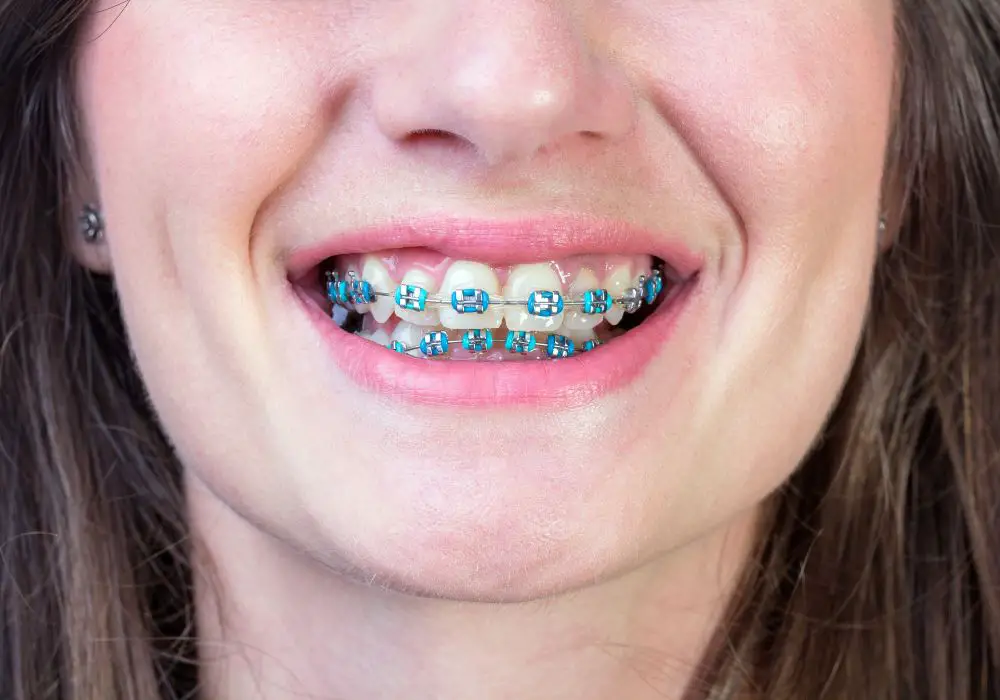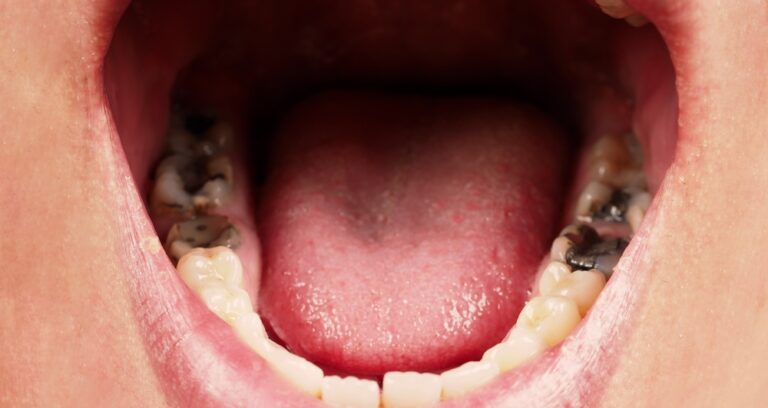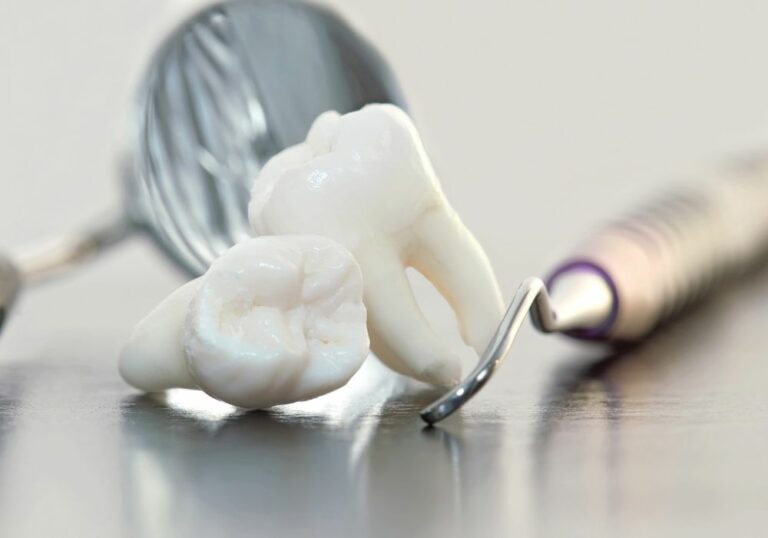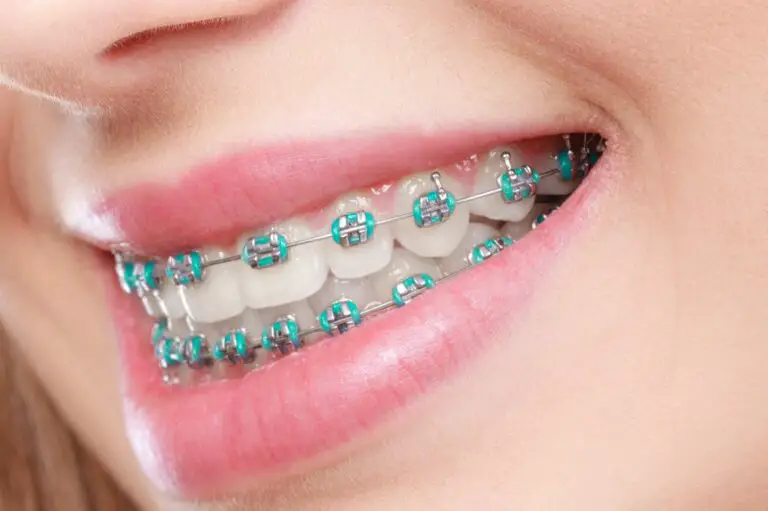Having a small gap between your front teeth is completely normal. In fact, many people find it gives character or makes their smile unique. However, if you opt for braces to fix alignment issues with your teeth, you may notice the gap getting bigger rather than closing up. This can be alarming, but there are reasons it happens and things you can do to fix it.
What causes a gap to increase with braces?

There are a few potential causes for a tooth gap widening with braces:
Expansion of the dental arch
One of the first steps in braces treatment is expanding the dental arch – the entire upper or lower set of teeth. This creates more room in your mouth for teeth to shift into their ideal positions.
- The arch wires that run across the braces brackets exert outward pressure on the teeth to widen the arch. This gradual expansion makes space for crowded teeth to move.
- Expanders may also be used to increase arch width. These devices, like palatal expanders for the upper jaw, swiftly push the back molars outward. This immediately creates more space in the arch.
- As the dental arch widens through these methods, the gaps between individual teeth are also stretched bigger. This normal side effect helps make room for teeth alignment.
But arch expansion and the resulting gap increase is only temporary. Once expanded, the arch will be stabilized. Then when teeth are properly positioned, they can shift back together to close spaces.
Movement of teeth
The entire goal of braces is to shift your teeth into proper alignment based on your unique bite. As teeth start moving, gaps can open up temporarily between them.
- Teeth tend to drift or flare outward when braces are first placed and pressure is applied by the wires. This movement away from each other widens the spaces between them.
- The teeth are gradually tipped back into position over time. But as they upright, gaps may still occur as the teeth descend into the arch.
- Rotating or torquing teeth can also influence gap size. As teeth turn, their edges splay outward, enlarging spaces before coming back together.
- This gap increase during the movement process is normal and expected. Just because you see a wider space does not mean your teeth won’t fill it in as treatment continues.
Extractions
Some patients require one or more permanent teeth extractions before braces to relieve extreme crowding or bite issues. This orthodontic procedure leaves more available space in the mouth.
- With a tooth removed, it is normal for gaps to form near the extraction site as the remaining teeth shift and tip into the open space.
- Arch length decreases are also done to create space in crowded arches. This entails shaving between back teeth so they drift together, opening gaps that teeth can then move into.
- Gap spaces may look more pronounced after extractions since teeth are actively moving into the newly freed up room. But with time, these gaps should diminish as closure occurs.
Tongue thrusting
Some people have an unconscious habit of exerting excess tongue pressure on their teeth when swallowing or speaking. This subtle force, called tongue thrusting, can slowly influence tooth positions.
- Tongue thrusting often causes front teeth to flare outward, which widens the space between them. This is especially true with braces, as teeth become more pliable.
- The constant outward pressure from swallowing or speaking makes the teeth more prone to being pushed apart. This can hinder proper movement from the braces.
- Braces alone make teeth more movable, increasing the impact this harmful habit can have. Eliminating tongue thrusting is needed for ideal tooth alignment and gap closure.
When does a gap closing become concerning?
In most cases, a slight widening of spaces between teeth is nothing to worry about. But there are certain times when a increasing gap warrants attention or intervention:
- If the gap rapidly increases in size over a short period of time, such as a couple months. Minor gradual changes are expected, but sudden exaggerated widening may signal an underlying problem.
- If gaps are still quite wide and show no sign of closing after 1 year or more in braces treatment. At this point, progression should be occurring, so stalled movement is a concern.
- If only one space between two teeth is dramatically increasing in size while other gaps appear to be closing properly. This isolated change likely means something is impacting only that tooth pair.
- If you develop new gaps between other teeth that didn’t previously have a space. While existing gaps can get bigger, new ones signal bigger issues.
These situations indicate that something is preventing the normal gap closure process during orthodontic treatment. Dramatic unilateral changes in gap size need to be addressed promptly to keep braces progress on track.
Tips to help close a gap with braces

If you want to actively help close spaces between your teeth during orthodontic treatment, there are a few things you can try at home:
Wear elastics as directed
Rubber bands or elastics are often prescribed to braces patients. The orthodontist strategically determines where they are attached to provide optimal pressure between specific teeth.
- Wearing elastics consistently and as instructed can help bring teeth together more quickly. The elastic forces draw the teeth toward each other, diminishing the space.
- Be diligent about wearing your elastics full-time, only removing them for eating and oral hygiene. Keep up the routine daily to get the most benefit.
- Always replace elastics with fresh, unstretched ones as directed. Rotating them ensures the pressure remains strong enough to move teeth.
Avoid tongue thrusting
Consciously try to break the habit if you have a tendency to push your tongue against your teeth when swallowing or speaking. Keeping proper tongue position requires effort.
- Train yourself to rest your tongue against the roof of your mouth rather than your teeth. Practice holding it in place when talking and swallowing.
- If you catch yourself thrusting, stop and actively reposition your tongue correctly. It takes time to relearn unconscious behavior.
- Reducing this pressure on your teeth prevents the tongue from influencing the gaps to widen. This allows braces to work most effectively.
Get required extractions
If pre-braces x-rays show that crowding or bite issues are contributing to a persistent gap, extracting the recommended permanent teeth can help.
- This extraction opens up needed space in the mouth. As remaining teeth migrate into the freed up space, they tip less dramatically. This allows more controlled, stable movement.
- With room to align properly, the post-extraction teeth should be able to meet and close the gap more predictably.
- Just be sure extractions are truly the best option before proceeding. Consult your orthodontist on the pros and cons.
Consider restorative solutions
In some situations where a gap is too wide to completely close with braces alone, restorative treatments may be needed. These are typically done after braces, but can be discussed ahead of time.
- Dental veneers adhered to the sides of teeth or dental bonding applied to the edges camouflage extra space. These make teeth appear wider, filling the gap.
- More invasive options like crowns fully cover and cap teeth. These are customized to meet and eliminate the space between capped teeth.
-Restorative dentistry can achieve an aesthetic gap closure result when orthodontics alone falls short. Talk to your orthodontist to see if these options may be right for you.
Be patient!
It’s important to remember that spacing issues may temporarily look worse before they get better during orthodontic treatment. Teeth need time to align.
- Allow for the expected duration of treatment – this can take 18-24 months on average. Rushing the process rarely produces the best results.
- The gap should gradually diminish in size over the course of braces as the teeth slowly shift closer together into proper alignment.
- Trust the process and discuss any concerns openly at adjustment visits. With patience and compliance, the space should resolve.
When to consult your orthodontist about a widening gap
Don’t panic if you notice a small increase in space between your teeth initially after getting braces. But do contact your orthodontist promptly if you see:
- Sudden, rapid widening of a gap over a week or two rather than gradual change. This signals something impacting the tooth faster than normal.
- Significant gap size increase after 6 months or more of braces treatment time. At this point, spaces should be stabilizing instead of enlarging.
- One gap getting substantially bigger while the spaces between your other teeth appear to be closing or stable. Targeted unusual movement needs to be addressed.
- New wider gaps forming between teeth that previously met nicely without spacing. This often indicates an external force on the teeth.
Schedule an appointment as soon as possible if any of these occur. Come prepared to discuss your concerns, when you first noticed the change, and any habits like tongue thrusting. This helps the orthodontist pinpoint the cause. They can then check for issues and recommend solutions to correct course, like elastics or restorative treatments after braces. Prompt attention ensures the gap resumes closing as planned.
Treatment options to close a gap after braces

Unfortunately, spaces between teeth may still remain to some degree after braces come off. But several options are available if gaps did not fully close with your initial orthodontic treatment:
Clear aligners
Custom clear aligners like Invisalign, an alternative to braces, can further shift your teeth in minor ways. This may help close small lingering gaps.
- Aligners are smooth, transparent trays that incrementally move teeth into better position. Treatment is usually shorter and more subtle than braces.
- They are an especially good choice if gaps reopened slightly due to not wearing your retainer properly after braces. The aligners can re-correct minor relapse.
Permanent retainers
A fixed wire can be permanently bonded behind the teeth to hold them in their corrected position after braces. Wearing a permanent retainer long-term may slowly help close the gap.
- The thin wire keeps constant gentle pressure on the teeth, preventing them from shifting. Over months or years, this can encourage prolonged, gradual gap closure.
- Retainers are typically needed indefinitely post-braces to maintain results. In the case of a gap, it may yield the added benefit of pulling the teeth together.
Dental bonding
Tooth-colored bonding material can be adhered to the sides of teeth adjacent to a gap. This makes the teeth look wider, which can mask or fill in the empty space.
- Reshaping the edges of the teeth may be done first to allow more surface area for the bonding material. Then it is applied and hardened with a curing light.
- Bonding offers a cosmetic fix and is minimally invasive. But it does grind down some natural tooth structure. It also needs replaced every few years as it stains and deteriorates.
Dental crowns
Dental crowns or caps are placed over teeth after filing them down. The crowns meet to create the appearance of closed gaps between teeth.
- More invasive than bonding, crowns require reshaping the natural teeth extensively to place the cap over them. Your tooth’s inner pulp remains intact.
- Custom crowns are made to match your natural tooth color with no space between them. But crowns do remove significant healthy tooth structure.
Orthodontic relapse treatment
Teeth that revert back toward their original positions after braces may reopen spaces that previously closed. A second round of braces (or clear aligners) may be needed to move the teeth again.
- This retreatment works the same as initial braces, but is typically shorter in duration. The teeth are re-aligned to reclose gaps that opened from orthodontic relapse.
- For the best outcome, be sure to wear your retainers properly in the future to prevent repetition of unwanted tooth movement.
Discuss the options with your orthodontist to determine the best approach based on your particular case, treatment goals, time frame, and finances. With persistence, spaces can still diminish even after braces through alternative corrective methods.
Maintaining gap closure after braces
Once your orthodontic treatment successfully closes the spaces between your teeth, preserving those results long-term is crucial. Be diligent about the following steps to prevent relapse or gaps reopening:
- Wear your retainers exactly as instructed, especially at night while sleeping. Some patients need to wear their retainers full-time for many months post-braces before transitioning to just nighttime wear. Retainers keep teeth from shifting back and gaps from returning.
- Attend all scheduled retention checkup appointments with your orthodontist. They will monitor tooth positions very closely for any evidence of relapse or unwanted movement. Subtle changes can be caught early and corrected before a gap returns. Most patients need to be seen every 4-6 weeks at first.
- Avoid placing habitual pressures on your teeth via things like tongue thrusting, finger/lip sucking, chewing on pens, and nail biting. Any external forces could slowly push teeth out of place.
- Get bonded permanent retainers promptly replaced if they start to come loose or break. The fixed wire must remain fully intact to keep holding teeth in position. A partially detached retainer cannot prevent relapse.
- Continue practicing good oral hygiene and home care habits. Flossing and brushing keeps teeth and gums healthy while wear retainers. Skip cleaning promotes decay and gum disease that could undermine braces results.
Closely following post-orthodontic protocols gives you the best chance of the gaps remaining closed long after your braces come off. Small spaces may still open slightly over the years as minor relapse is common. But ideal retention maintenance will ensure the gaps remain minimal.
Answers to common questions about gaps widening with braces

Concerned about seeing a tooth gap increase while wearing braces? Here are explanations for some frequently asked questions:
Why is my gap getting bigger with braces?
As braces exert calculated forces on your teeth to align them, spaces between teeth can temporarily enlarge. This is normal during the initial leveling and aligning stage as teeth shift toward their final ideal positions. Gaps should begin to decrease again over time as the teeth migrate closer together into proper alignment.
Should I worry if my gap widens with braces on?
In most cases, a slightly widened gap is nothing concerning, especially early in treatment. But notify your orthodontist promptly if the space rapidly increases in size over a short timeframe. This may signal something impeding the expected closure. They can then check for issues.
How can I get my tooth gap to close faster while in braces?
Consistently wear any elastic bands/rubber bands that are prescribed to pull teeth together. Stop any tongue thrusting habits that may be pushing teeth apart. Consider recommended extractions to alleviate severe crowding if suggested. And be patient during the aligning phase – gaps sometimes appear bigger before closing.
What if my gap doesn’t close after my braces come off?
If spaces remain after your initial braces treatment, options like clear aligners, permanent retainers, dental bonding/veneers, restorative crowns, or more braces can still help close them. Discuss the best choice for your situation with your orthodontist.
How do I prevent my closed gap from reopening after braces?
Closely follow your orthodontist’s post-treatment retention protocol by wearing retainers consistently, attending all follow-up visits, avoiding pressure on teeth, and getting bonded wires repaired. Proper retention care keeps your teeth stable in their corrected positions.
Summary
Seeing a tooth gap enlarge while wearing braces is usually nothing to be concerned about. As the dental arch widens and teeth begin moving, spaces between them may temporarily open up. Eventual closure just takes time as treatment progresses and teeth drift into better alignment. But notify your orthodontist promptly if any spaces exhibit rapid, unilateral, or uncontrolled widening. Intervention like elastics, habit changes, or extractions can get gaps diminishing again. With diligent braces wear and retention, the gaps should disappear, leaving you with a beautiful new smile.







